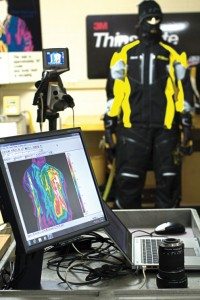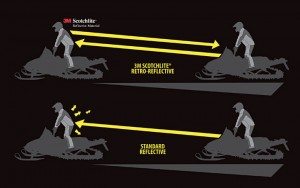Producing better gear through science
Klim’s partnership with supplier 3M leads to advanced gear technology
Deep within the grounds of a 3M Twin Cities, Minn., research facility that’s off-limits to the public, gear maker Klim assembled the snowmobile media on a pitch-black night to demonstrate the importance of reflectivity on its latest line of jackets and bibs.
Sure enough, as our minivan’s headlights slowly approached a herd of geared-up test dummies who were walking in place hundreds of yards away — actually 3M reflectivity researchers — it was vividly apparent that more, strategically placed reflective patches made a world of difference in terms of visibility. The researchers wearing Klim’s latest winter apparel, enhanced with more 3M Scotchlite reflective material than the Idaho-based gear maker has ever used before, stood out much sooner and were immediately identifiable as human beings, rather than appearing to be a mailbox or other generic roadside object. This realization was one of the main purposes of the event: educating off-road media about the importance and safety of standing out at night.
The next day, 15 minutes north at 3M’s sprawling headquarters in Maplewood, Minn., another team of researchers and Klim officials explained the science of warmth, and how the many variants of 3M’s Thinsulate insulation is used by the Idaho-based gear maker to build winter wear that’s methodically tailored to snowmobile riders.
Technology partners
Continuing a long-standing partnership between 3M and Klim, the two companies collaborate to create gear that, in the words of Klim’s marketing manager, John Summers, “is only as good as the ingredients we put into them.”
At the highest echelon of snowmobile gear, Klim’s commitment to its high internal standards includes simultaneously focusing on warmth, comfort, breathability, mobility, durability and nighttime visibility.
Klim’s in-house research shows that motorsports enthusiasts want and are willing to pay for more features in their apparel, and the 14-year-old company’s recent success — culminated with Klim’s recent purchase by Polaris — supports that stance.
“It’s not about smoke and mirrors, it’s about actual science,” Summers said.
After the event’s first evening spent shining lights on researchers at 3M’s Cottage Grove, Minn., plant and reflectivity test center, the following day was spent within Thinsulate insulation laboratories and exploring 3M’s Innovation Center, where many of the company’s advancements are on interactive display, including adhesives, advanced films that make touch-screens possible, nanotechnology, biotechnology, advanced materials and more.
As a 3M client, Klim has access to many of the company’s supplemental resources, including exhaustive testing to ensure that its high-tech winter apparel not only performs well and looks good, but can also last for years in the harshest conditions — as was demonstrated in cold-air chambers and rooms filled with industrial-grade washing machines to rapidly age garments.

“Right from the beginning we were getting support from 3M that we weren’t getting from any other company,” Summers said. “That’s the involvement we want with our technology partners.”
Beyond selling the media on Klim’s virtues, another focus of the event was educating the snowmobile media to become better, more informed evaluators of modern cold weather wear.
While snowmobile thought leaders know the importance of layering and synthetic materials that wick away moisture, 3M’s attendant scientists explained how heat loss is affected by body temperature, activity level, outside air temperature and wind speed, duration of exposure, distances between the insulation fibers, thickness of insulation and fiber size.
Their points were demonstrated using walk-in coolers and thermal imaging that clearly showed the pros and cons of differing types of insulation, and explanations for how more warmth isn’t necessarily an advantage in all conditions, like for high-exertion mountain riders who need much less insulation. Ideal insulation for outdoor athletes depends on the rate of the body’s heat production, insulation value of the clothing (measured by clo value) and environmental temperature.
Brighter ideas
Many snowmobile jackets come with reflective piping that provides a striking accent when camera flashes come out at racing events, yet 3M’s Shari Franklin Smith said this type of reflectivity is generally ineffective because the human eye cannot tell what it is seeing.
“Piping doesn’t work,” she said, explaining that the body is confused by thin strips of light, and the eye cannot spot piping from great distances.
Instead, she said, gear makers need to focus on using higher quality reflective materials in a strategic way, focusing on the bio-motion points of the body. Placing reflection on the chest, arms and legs — even small patches — makes the form immediately visible as a human being even from afar. Small differences, Franklin Smith said, can make a big difference in the field or on the trail.
According to a 3M report, “Drivers moving at just 30 mph could travel a distance over 500 feet before they are able to properly maneuver their vehicle in response to an obstacle; yet a pedestrian wearing a white shirt may not be visible to drivers until they are within 300 feet of the car.”
Pulling the message back to Klim’s corporate DNA, Summers said that the company adheres to five key ideas: passion, precision, people, places and process. Going back through its 14-year history, the high-end gear maker continues to focus on its passion for powersports, the precision and standards it requires for its gear, the many talents of its constantly growing workforce, its strategic location in eastern Idaho and a process that the company says separates it from its competition.
New gear
The end of the two-day event included an introduction of Klim’s new-for-2014 snowmobile gear. New items included a revision of the popular super-cold-weather Keweenaw Jacket and Bib, the advanced Stealth Jacket and Bib aimed at extreme backcountry riders, the all-new women’s Aurora GTX Boot, a revision of the popular Klimate and the new, brightly styled women’s Allure Parka and Bib that are designed to insulate and breathe with a minimal amount of bulk.
Improving nighttime visibility

1. To be seen, reflectivity must mark bio-motion points that indicate the human form.
2. 360-degree visibility is key for safety.
3. Use enough reflective material, and of a sufficient width, to be
visible from far away.
4. Add fluorescent materials to further improve visibility.








